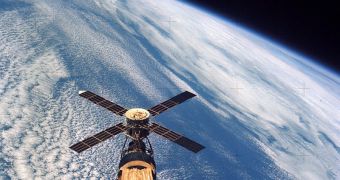The U.S. officials were very evasive in their press statement released on Saturday, which could be related to the fact that the giant orbiter is a spy satellite. It is unclear when the satellite lost power or when and where it will hit the Earth. What is known is that it cannot be controlled anymore, is quickly decaying orbit and may spread a series of hazardous materials in the atmosphere during the re-entry. The U.S. government chose to give little detail about the satellite because most of the information related to it is classified as top-secret.
Over the years, multiple satellites have fallen harmlessly into the Earth's atmosphere, but most of them made controlled re-entries and were much smaller than this one, thus they didn't contain a great deal of hazardous material. National Security Council spokesman Gordon Johndroe stated that several agencies are currently monitoring the situation of the rogue satellite, to ensure that others will not be damaged in the process.
Although it may not seem like a very hazardous situation, the U.S. seem to think otherwise, and are even considering shooting down the satellite with the help of a missile, in order to protect state secrets. Typical spy satellites are sent into a forced re-entry long before they lose power, to avoid the situation of being unable to control its fall. Usually they are put into trajectory courses that take them over ocean surfaces, where the possibility of recovering eventual debris is rather remote.
Defense and intelligence expert John Pike estimates the weight of the behemoth at about 10 metric tonnes, which is the rough size of a small bus, and during the re-entry could generate an amount of debris about 10 times less than that resulted during the disintegration of the space shuttle Columbia, back in 2003.
Pike argues that the biggest threat is the fact that the satellite contains relatively high amounts of beryllium, that would not burn so easily into the atmosphere due to its high melting point. Beryllium is routinely used in the defense and aerospace industries, and could easily reach the surface of the Earth.
The satellite was used as a reconnaissance orbiter to take photographs of nuclear sites and military facilities, but for civilian purposes as well, in order to overview fires and natural disasters or damage produced by hurricanes.
In 1979 occurred the largest uncontrolled re-entry in the history of mankind, when the U.S. space station Skylab, weighing about 78-tons, decayed orbit and fell towards remote regions of the Australian continent and the Indian Ocean. Eight years ago, the Compton Gamma Ray observatory was safely put into a re-entry trajectory with the help of the rockets onboard and fell in the Pacific Ocean.
On the other hand, a controlled re-entry would not always guarantee that the spacecraft would fall in the designated spot. For example, in 2002, a science satellite weighing about 3,5 tonnes fell down to Earth over regions of the Persian Gulf, thousands of kilometers away from the predicted location.

 14 DAY TRIAL //
14 DAY TRIAL //